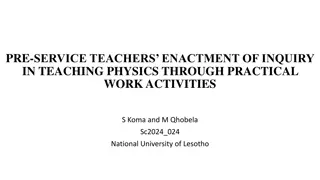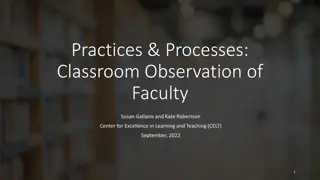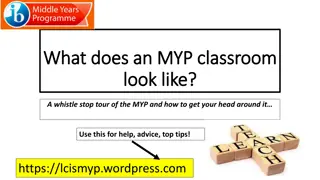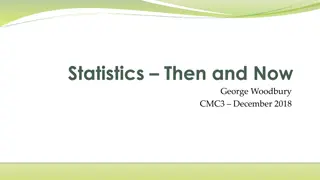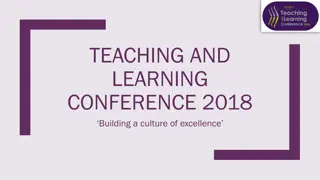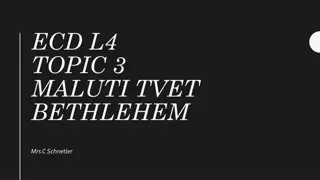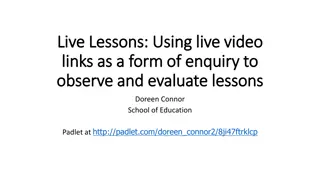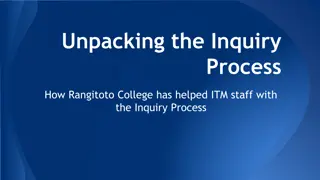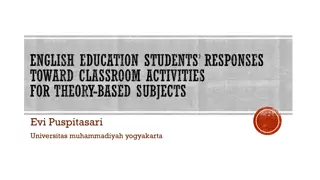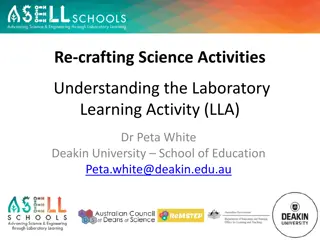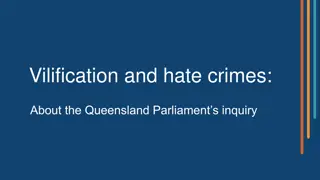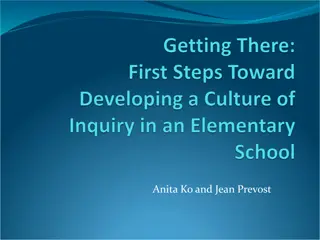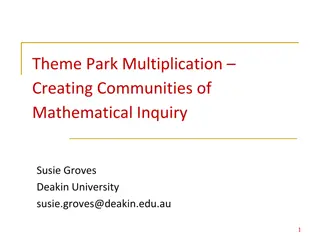Influence of Culture on Teaching and Learning in an Inquiry-Based IB Classroom
This paper delves into the impact of cultural values on teaching and learning processes within an inquiry-based International Baccalaureate (IB) classroom. The author explores the sensitivity of educators towards cultural influences, especially in settings where knowledge is socially constructed. Highlighting the challenges students face when navigating between home culture and school learning culture, the study incorporates Bernstein's Theoretical Framework to analyze classroom dynamics and interactions through the lenses of Restricted Code and Elaborate Code.
Download Presentation

Please find below an Image/Link to download the presentation.
The content on the website is provided AS IS for your information and personal use only. It may not be sold, licensed, or shared on other websites without obtaining consent from the author. Download presentation by click this link. If you encounter any issues during the download, it is possible that the publisher has removed the file from their server.
E N D
Presentation Transcript
Cultural values and student expressions in an inquiry-based IB classroom Bernstein s Theoretical Framework S Govindswamy Sunder
Introduction Sudha Sunder Staff and Curriculum Development Coordinator Universal American School, Dubai- American IB World School 70 different nationalities in student body Curriculum Consultant- concept-based trainer- consult with international schools in curriculum development Completing my EdD dissertation- University of Bath UK Teacher perceptions in school-based curriculum development initiatives S Govindswamy Sunder
Focus of this paper Does culture influence the way we teach and learn? Though we understand learning as a cognitive process, few of us would contest the notion, that culture influences the way we teach and of course, the way we learn. How sensitive are we to this when we teach, particularly in the context of an inquiry-driven IB classroom, where knowledge is socially negotiated and constructed? S Govindswamy Sunder
Home Culture VS School learning culture How sensitive are we, as teachers, to the fact that some students continue to be challenged with clashes between the 'home culture' where questioning and debating with 'authority' is not acceptable, but in the 'learning culture' at school, this is an 'expectation'? S Govindswamy Sunder
Unpacking the questionshow? through Bernstein s theoretical framework Classification and Framing Restricted Code and Elaborate Code (acknowledge the challenge in terms of the complexity of Bernstein s theories, particularly in relation to other concepts developed over time ) S Govindswamy Sunder
Why Bernstein? Bernstein (1975) formulated theories bottom-up: Micro to Macro Analyzing classroom interaction- which I believe is very powerful An approach that sought to write the rules of educational processes; then to link them to larger structural conditions and finally, to place this analysis in the context of the larger educational and policy questions of educators . (Sadovnik 2001, p.5). Acknowledge that Bernstein did not generate these theories in the light of international education Nevertheless very powerful in terms of unpacking classroom dynamics S Govindswamy Sunder
Strong and weak Classification According to Bernstein (1971), classification indicates the degree of boundary that is maintained between different things in the school: Where classification is strong, contents are well insulated from each other by strong boundaries. Where classification is weak, there is reduced insulation between contents, for the boundaries between contents are weak or blurred. Classification thus refers to the degree of boundary maintenance between contents. (Bernstein 1971, p.49; emphasis in original). S Govindswamy Sunder
Strong Framing Where framing is strong, the teacher controls, what is taught/learnt, in what sequence/order, the time allocated to differing parts of instruction and the legitimacy (correctness) of the learning is assessed by the teacher. Here, the locus of control for all aspects of curriculum, pedagogy and evaluation (assessment) reside with the teacher- traditional teacher-centered education) S Govindswamy Sunder
Weak Framing Where framing is weak, control over the selection, sequence, pace and criteria of the pedagogic interaction are in the control of the learner. In this case, the rules that regulate behavior and instruction are invisible or implicit to the learner (Bernstein, 2000). S Govindswamy Sunder
IB Programs- Classification and Framing Could be argued that.. IB PYP- MYP- Weak classification and framing IB DP- Strong classification and framing S Govindswamy Sunder
Code Theory Bernstein analyses one of the ways in which the dynamics of social class affects learner outcomes in school the language patterns of working-class and middle-class families and children S Govindswamy Sunder
Social class and learner outcomes Bernstein argues that the form of language use of working class (who speak a restricted code ) as contrasted with middle class students (who speak an elaborated code ), in part explained their comparative performance at school. S Govindswamy Sunder
Education cannot compensate for society Bernstein (1971)argues that the language of working class children is context specific: it is locked into specific relationships in particular social situations, and it is predictable. Because it is context specific, Bernstein calls it a Restricted Code . This is contrasted with middle class language, in which meaning is more abstract and universalistic, which he calls the Elaborated Code . S Govindswamy Sunder
Caution.. The restricted code does not refer to restricted vocabulary, and the elaborated code does not entail flowery use of language... S Govindswamy Sunder
The theory that social class relationships shape the structure of communication Social class is Working class Middle Class Spoken language is Context bound Less context bound Meanings are Particularistic Universalistic Principles are Explicit Implicit The Code is RESTRCITED ELABORATE Creative Commons Attribution 3.0 licence. http://creativecommons.org/licenses/by/3.0/ Restricted Code Inhibits orientation to symbolize intent in a verbally explicitly form Elaborate Code Facilitates orientation to symbolize intent in a verbally explicit form Org. structure regardless of complexity is wholly predictable and hence very ritualistic Less predictable more complex and abstract S Govindswamy Sunder
Elaborate codes and success at school Bernstein s research argued that working-class students had access to their restricted code(s) but middle-class students had access to both restricted and elaborated codes, because the middle classes were more geographically, socially and culturally mobile. middle class children thus have access to the language codes required to be successful at school whereas working class children do not S Govindswamy Sunder
Elaborate codes for educational success Bernstein suggested that schooling rewarded formal language. ..if you can't handle elaborated code, you are not going to succeed in the educational system S Govindswamy Sunder
In the culturally varied IB classroom Inquiry-based IB classrooms- Here, the learner takes responsibility for determining what they learn (curriculum), how they learn it (pace, sequence), when they have arrived at a legitimate end to the learning (evaluation) However...in the context of cultural constraints how do some students achieve this, particularly when they have access only to restricted codes ? S Govindswamy Sunder
Points of Reflection How restricted are some students from expressing themselves, and why? Particularly in terms of some cultures? S Govindswamy Sunder
Students Restricted Code It is about the embarrassment which many students may feel when asked to express themselves (speak in class) in an elaborated-code. Do some cultures experience this more than the other? And why? It is about the reassurance and security often achieved through restricted codes .. S Govindswamy Sunder
Teachers restricted code Remember that when teaching the misunderstandings may come not from your use of elaborated code, but from your use of your restricted code, adapted to your own speech community (jargon, abbreviations, etc.), rather than a properly and appropriately elaborated code Atherton J S (2013) S Govindswamy Sunder
Role of the teacher How can we as teachers facilitate the movement from the students usage of restricted code to elaborate code.. S Govindswamy Sunder
Discussion and Questions Thoughts and input from audience Do we agree or disagree and why? Any thoughts to tackle the issue? S Govindswamy Sunder
Recommendations Not suggesting that every educational problem has a solution Sometimes being aware of this helps to a large extent Being aware of our own restricted code as teachers Mother tongue- involvement of parents Software/technology Discussion boards Software platform that help students articulate and develop their thoughts in complex and abstract ways S Govindswamy Sunder
References Atherton J S (2013) Doceo; Language Codes [On-line: UK] retrieved 29 September 2014 from http://www.doceo.co.uk/background/language_codes.htm Language Codes http://www.doceo.co.uk/background/language_codes.htm#ixzz3EgS7MZ3I Under Creative Commons License: Attribution Non-Commercial No Derivatives Bernstein, B (1971) Class, Codes and Control vol 1 London; Paladin. Bernstein, B. 1971. Education cannot compensate for society. School and Society: A sociological reader. Cambridge: Open University), 61-66. Bernstein, B.,1971. On the Classification and Framing of Educational Knowledge. In M. Young (Ed.), Knowledge and control (p. 47-69). London: Collier-Macmillan. Bernstein, B., 2000. Pedagogic, Symbolic Control and Identity. Oxford, England: Rowman & Littlefield Publishers, Inc. Douglas, M (1973) Natural Symbols Harmondsworth; Penguin Labov, W (1969) "The Logic of Nonstandard English" reprinted in P Giglioli (ed.) Language and Social Context Harmondsworth; Penguin 1990 Sadovnik, A. R., 2001. Basil Bernstein (1924-2000): sociologist, mentor and friend. In P. Aggleton, J. Brannen, A. Brown, L. Chisholm, J. Mace & S. Power (Eds.), A Tribute to Basil Bernstein: 1924-2000. London: Institute of Education. Language Codes http://www.doceo.co.uk/background/language_codes.htm#ixzz3EgSn2K3G Under Creative Commons License: Attribution Non-Commercial No Derivatives S Govindswamy Sunder





